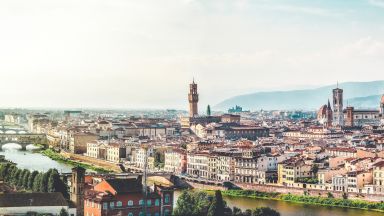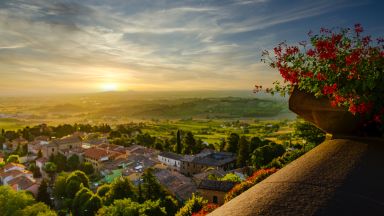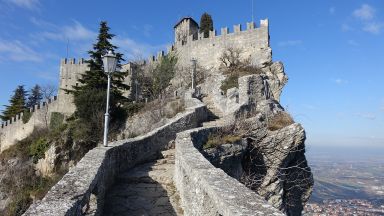Self-Guided Walking Tour of Bologna (With Maps!)
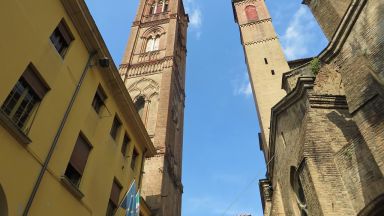
This website uses affiliate links which earn a small commission at no additional cost to you.
Italy is renowned for its captivating cities and towns, but none compare to the breathtaking beauty of Bologna. This enchanting city boasts miles of medieval porticoes, recognized as a UNESCO heritage site, adorning the streets with a captivating interplay of light, shadows, and architectural splendor. Adding to Bologna’s allure are the terracotta buildings that grace the old town, earning it the nickname “La Rossa” (The Red).
At the heart of this remarkable destination lies the majestic Piazza Maggiore, a central square surrounded by significant medieval structures, including the Basilica of San Petronio, Palazzo del Podestà, Palazzo Comunale, Palazzo dei Notai, and Palazzo dei Banchi. Just a stone’s throw away from Piazza Maggiore, one can wander through blocks of picturesque streets bursting with vibrant colors. Among these charming lanes lies the delightful market district of Quadrilatero.
Arriving at Bologna by Car: Much of the old town is part of the ZTL, the limited traffic zone and that the access points of the ZTL are monitored by cameras so you will probably want to park outside the old city and walk in. I suggest parking at Parking Tanari, good value and positioned near the train station.
Arriving at Bologna by Train: The train station of Bologna, from which run both regional and long-distance trains, is located in the centre. Consider it is basically attached to via Indipendenza, the shopping street of Bologna, and about 15 minutes walk from Piazza Maggiore.
Fontana Vecchia (Old Fountain)
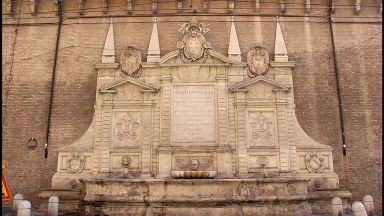
From the Train Station: Walk out of Bologna Centrale’s main entrance and turn left. Turn right onto the first major street, Via dell’Independenza. Continue for about 15-20
minutes and the street will dead-end at a large piazza; there, just before you enter the piazza, turn right on Via Ugo Bassi and walk about half a block to reach the Fontana Vecchia.
Our tour begins at Fontana Vecchia. From here, you can admire the external walls of the ancient fortress, gaining a glimpse into the medieval era when the city of Bologna was frequently besieged. The roots of Bologna’s settlement date back to around 1,000 B.C.E., with the Etruscans establishing the first urban centre known as “Velza” (or “Felsina” in Latin) in 534 B.C.E. Throughout history, the region experienced conquests by the Celts and Gauls, eventually becoming a Roman colony called “Bononia” in 189 B.C.E.
In 88 B.C.E., Bologna evolved into a municipality, but it faced significant challenges following the decline of the Roman Empire. However, in the 5th Century, the city underwent reconstruction and emerged as a pivotal crossroads for transportation in medieval Europe. Resembling Venice, Bologna boasted an extensive canal system and played a vital role in trade, banking, and finance. The prestigious university, established in 1088, attracted a diverse international population and continues to educate approximately 80,000 enrolled students each year.
Commissioned by Cardinal Legate Carlo Borromeo, who would later become Pope Pius IV, the Old Fountain (Fontana Vecchia) was designed in 1563 by the esteemed sculptor and architect Tommaso Laureti from Palermo, Sicily. The construction of the fountain was overseen by Vicelegate Pier Donato Cesi. Its purpose was to provide the public with a water source, discouraging them from using the Fountain of Neptune.
According to a plaque nearby, it is believed that the vendors from the bustling Piazza Maggiore market would clean their vegetables in the Fountain of Neptune, making the presence of the Fontana Vecchia even more significant in ensuring a separate water supply for the general population.
Location: Fontana Vecchia, Via Ugo Bassi, Bologna, Metropolitan City of Bologna, Italy | Hours: 24 Hours | Price: Free
Read more about Fontana Vecchia
Fountain of Neptune (Fontana del Nettuno)
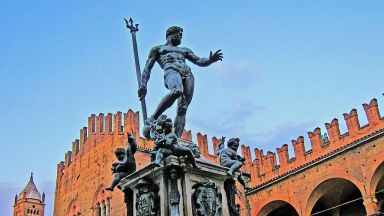
Walk to the east along Ugo Bassi (in the direction of the large tower) and stop when you reach the giant Neptune fountain in the main square.
Crafted between 1563 and 1566, the Fountain of Neptune (Fontana del Nettuno) stands as a masterpiece created by the skilled Flemish sculptor Giambologna. This remarkable fountain portrays Neptune, the mighty sea god, symbolizing the immense power of the Pope, who, like Neptune, reigned over the world. Nestled at the feet of Neptune are four angelic sculptures representing the rivers of the four continents recognized during the Renaissance: the Ganges, the Nile, the Amazon, and the Danube.
The commission for the Fountain of Neptune also included the design of its base, which was entrusted to Tommaso Laureti by Pope Pius IV. Adjacent to the fountain, you will find a smaller fountain from which potable water flows, offering a refreshing drink to quench your thirst.
It is widely known that the figure of Neptune in the fountain holds a rather assertive pose. According to legend, during the sculpture’s creation, the Pope expressed dissatisfaction with the size of Neptune’s genitals and requested Giambologna to diminish their prominence. Reluctantly, Giambologna complied with the Pope’s request. However, as a subtle act of retaliation, he altered the positioning of Neptune’s left arm, extending the thumb and index finger. The outcome of this alteration becomes apparent on sunny days when standing behind Neptune, as the elongated shadow cast by the arm takes on a phallic shape, playfully implying a sense of excitement, so to speak…
Location: Piazza Nettuno, Bologna, Metropolitan City of Bologna, Italy | Hours: 24 Hours | Price: Free
Read more about Piazza Nettuno
Palazzo Re Enzo
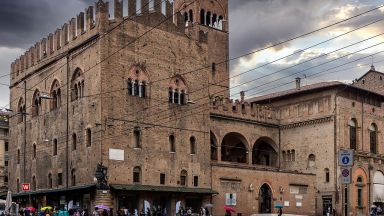
To the left of the statue of Neptune is the Palazzo Re Enzo.
Constructed in 1246, Palazzo Re Enzo served as the notorious prison where King Enzo, also known as Emperor Frederick II of Swabia, was held captive for a staggering period of more than twenty-three years. Over the centuries, the building underwent embellishments and expansions, eventually acquiring its current form following the meticulous restoration carried out by Alfonso Rubbiani in the early twentieth century. Rubbiani’s efforts successfully revived the palazzo’s authentic medieval essence, reinstating its original medieval aesthetic.
Entrance to the building is only possible when events are being held.
Location: Palazzo Re Enzo, Piazza del Nettuno, Bologna, Metropolitan City of Bologna, Italy
Read more about Palazzo Re Enzo
Monument to Fallen Partisans
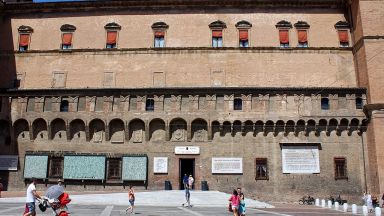
To the right of the Fontana del Nettuno is the Sacrario dei Caduti della Resistenza per le Libertà e la Giustizia or Monument to Fallen Partisans.
On the left side of the library entrance stands Bologna’s Memorial to the Resistance, a tribute to “The Fallen from the Resistance for the Liberty and Justice, the Honour and Independence, of the Homeland.” Erected in 1961, the monument bears the dedication “To the children, women, and men of every race and nationality whom the Nazi brutality killed in internment camps.”
Bologna played a significant role as a stronghold of the Italian Resistance between September 8, 1943, and April 25, 1945. The memorial encompasses the names and portraits of Bolognese individuals who lost their lives during this heroic struggle. Additionally, it provides historical insights into the Bolognese partisan brigades. The central panel features photographs capturing the brave partisan fighters liberating Bologna in 1945.
Bologna’s contribution to the Resistance movement was profound, with 14,425 partisan fighters produced, including 2,212 women. Sadly, 2,059 partisans were killed, 945 were injured, and 6,543 were arrested. Retaliation for their involvement led to the execution of approximately 2,350 partisans by firing squad. Moreover, Bologna suffered extensive damage from Allied bombing campaigns due to its importance as an industrial hub involved in the construction of trains and machinery. The civilian population also experienced significant casualties as a result.
Location: Biblioteca Salaborsa, Piazza del Nettuno, Bologna, Metropolitan City of Bologna, Italy
Read more about Monument to Fallen Partisans
Biblioteca Salaborsa
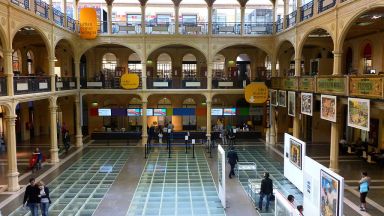
To the right of the Monument to Fallen Partisans is the entrance to the Salaborsa. Head inside to the public library and multi-media centre that opened in 2001. Head straight through the circular entryway and stop in the main atrium with the painted ceilings.
The name “Salaborsa” derives from its historical association with the borsa, or financial exchange market, that used to operate in this very location. Today, the building serves as a custodian of the city’s cultural heritage. Its magnificent atrium, bathed in natural light and adorned with painted ceiling motifs, is a popular spot where local professionals often pause for an afternoon coffee. When standing in the middle of the atrium and looking downward, you’ll notice that the floor is transparent, offering a glimpse into a Roman excavation site below. Visitors have the opportunity to freely explore this site. As you turn around to face the exit, you’ll find stairs and an elevator on your right, leading to the basement level. Descending the stairs and turning right will bring you to the entrance of the Archaeological Excavations (Scavi Archeologici). Inside the archaeological site, informative plaques in both Italian and English provide valuable insights.
Location: Biblioteca Salaborsa, Piazza del Nettuno, Bologna, Metropolitan City of Bologna, Italy | Hours: Monday: 2.30pm-8.00pm Tuesday - Friday: 10am- 8pm Saturday & Sunday: 10am to 7pm | Price: Free | Website
Read more about Biblioteca Salaborsa
Piazza Maggiore
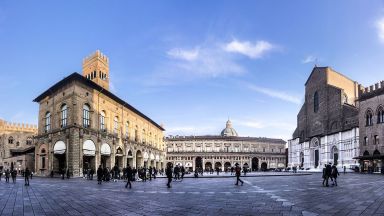
As you exit Salaborsa, the large square before you is known as Piazza Maggiore or Main Square.
Piazza Maggiore, the vibrant heart of the city, has embodied Bologna’s political and social life since its inception in the 13th century. As the square and its surrounding structures took shape, it became a symbolic epicenter. Today, it stands as one of Italy’s largest and oldest squares. Throughout history, this bustling square has served as a gathering place for citizens, who convened to hear the proclamation of new laws and witness capital executions. Moreover, Piazza Maggiore was once home to one of Europe’s most significant open-air markets, which thrived until the mid-1800s, attracting goods from all corners of the world.
The building to your right is the Palazzo d’Accursio, the Town hall complex dating from the 14th century, which is home to a fresco-filled chapel & fine art museum. Next to this, in front of you is the Palazzo dei Notai, built in the period 1384-1422 on a project by Antonio di Vincenzo. Next is the Basilica di San Petronio, which was begun to be built in 1390 on a project by Antonio di Vincenzo and although still unfinished, represents a splendid example of Italian Gothic and one of the most impressive Italian churches. Diagonally opposite you is the Palazzo dei Banchi which was the historic seat of the money changers and bankers, was built in 1412 and in 1568, after the restoration work based on a project by Vignola, the underlying portico was built, nicknamed by the Bolognese “Pavaglione”. Currently the arcade is occupied by glittering shop windows.
Location: Piazza Maggiore, Piazza Maggiore, Bologna, Metropolitan City of Bologna, Italy | Hours: 24 hours | Price: Free
Read more about Piazza Maggiore
Palazzo D’Accursio
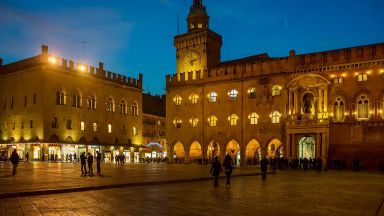
Once you enter the palazzo’s courtyard, head back to the right and you will find a large open ramp with raised curbs acting as steps. Continue up the stairs to the first floor.
Palazzo D’Accursio, the city’s town hall and residence of the City Art Collection, holds a rich history. The oldest section of the building came under city ownership in 1287, and subsequent renovations took place during the 17th and 18th centuries.
On the first floor you will find the impressive Hercules’ Hall (Sala d’Ercole), named after the magnificent bronze terracotta sculpture “Hercules Killing the Hydra” (“Ercole che Uccide l’Idra”) by Alfonso Lombardi, created in 1519 and displayed against the rear wall. Today, this room serves as a public art space where both modern and classical works are exhibited free of charge.
To the right of the Hercules statue, you will discover the City Council Chambers (Sala del Consiglio Comunale), previously known as the Senate Gallery (Galleria del Senato). In 1676, Angelo Michele Colonna and his apprentice Giocchino Pizzoli adorned the walls and ceiling with remarkable frescoes. These works are hailed as exemplars of the Baroque quadratura style, closely associated with the Bologna School. The artists skilfully employed perspective to create mesmerizing illusions of landscapes and vistas. One wall proudly presents the town’s coat of arms, supported by the virtues of Concord and Loyalty, symbolizing local and papal authority. Meanwhile, the central vault depicts allegorical figures from classical mythology, representing the essence of Bologna.
Proceed to leave Hercules Hall and make a right turn. Once you reach the end of the hallway, you will notice another set of semi-elevated steps on your left side. Ascend these stairs to reach the second floor.
The splendid ceremonial hall where you currently find yourself is named “Farnese Hall” or “Sala Farnese,” paying tribute to one of Italy’s renowned noble families. Adorning the walls are frescoes illustrating the glorious era of Papal dominance over the town. Positioned at the rear of the hall is a magnificent marble statue of Pope Paul III Farnese, placed between two expansive windows that offer captivating views of Piazza Maggiore.
To the right side of the hall, you will discover an entrance leading to the Farnese Chapel, an esteemed ceremonial location within the city. This architectural gem, constructed in the 15th century by the talented Aristotle Fioravanti, was adorned with frescoes in 1562. The chapel underwent a recent restoration in 1992, preserving its splendor for visitors to appreciate.
On the back left corner of the hall, you will encounter the entrance to the Collezioni Comunali d’Arte, a municipal art museum established in 1936 within the former chambers of the papal legate. To access the museum ticket office and bookstore, simply look across from the entrance, situated on the right side.
Location: Palazzo d'Accursio, Piazza Maggiore, Bologna, Metropolitan City of Bologna, Italy | Hours: From Tuesday to Friday: 09:00 – 18:30 Saturday and Sunday: 10:00 – 18:30 Monday Closed| Price: Free entry | Clock Tower & Art collections of Palazzo D'Accursio Audio Guide and Food Tasting
Read more about Palazzo d'Accursio
Basilica di San Petronio
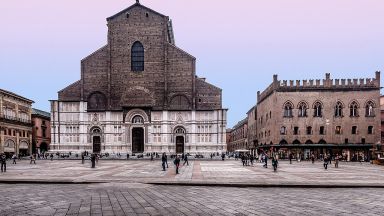
As you exit Palazzo D’Accursio the Basilica di San Petronio is diagonally opposite you.
It often appears that every Italian city boasts a pair of prominent churches—an ancient basilica and a Baroque-style church. As a national tradition, each city takes pride in highlighting something exceptional or distinctive about its own churches. Bologna, despite its relatively small size, showcases an astonishing array of colossal churches, with the most renowned being the Basilica di San Petronio, which gracefully dominates Piazza Maggiore. This grand structure was erected as a tribute to Bologna’s patron saint, Petronius, with construction taking place primarily between 1390 and 1479.
One notable feature of the Basilica is its unfinished façade. Initially, the Basilica di San Petronio was conceived as a civic endeavour rather than solely a religious edifice, intended to showcase Bologna’s municipal power. In 1514, work commenced on the elaborate marble façade, aiming to rival the grandeur of Saint Peter’s Basilica in Rome. However, when the Pope learned of this ambitious project, he exercised his papal authority to cease its funding. As a result, construction halted when the façade was only about one-third complete. Despite several subsequent attempts to finalize the façade, it remains unfinished to this day. The basilica was eventually entrusted to the diocese in 1929 and consecrated in 1954. In 2000, the relics of San Petronio were relocated there from Santo Stefano (stop 8 on the tour).
Upon entering the Basilica, you will encounter a central altar and choral area encircled by 22 smaller chapels. Bologna held a significant position as a hub of Baroque music in Italy, and San Petronio, in particular, gained renown for its choral and instrumental compositions. The basilica houses two organs, completed in 1476 and 1596, which are still played to this day. Additionally, the basilica’s library houses an extensive music archive.
Located on the ground to your left, you will notice a Meridian line meticulously embedded into the floor, serving as a sundial since its creation in 1655. Renowned astronomer and professor at the University of Bologna, Giovanni Domenico Cassini, calculated and designed this sundial, which, due to its remarkable length, boasted an exceptional level of precision for its era.
Another captivating area, easily overlooked, is the Basilica Museum tucked away at the far end of the church on the left side. Within the museum, you will encounter intricate models and depictions of the Basilica, precious religious artifacts, and exquisitely adorned manuscripts exhibited in glass cases.
Positioned at the back right, behind the altar, you will discover a remarkable Pieta crafted by Amico Aspertini, a prominent figure in the Bolognese School of painting during the 16th century.
Location: Basilica di San Petronio, Piazza Maggiore, Bologna, Metropolitan City of Bologna, Italy | Hours: Every day from 8.30am to 1.00pm and from 3.00pm to 6.30pm During the religious services, the tourist visit could be limited or suspended | Price: San Petronio: Free, San Petronio photo ticket: € 2,00, Cappella dei magi: € 5,00 / € 3,00, Museum: Free | Website
Read more about Basilica di San Petronio
Santuario di Santa Maria della Vita
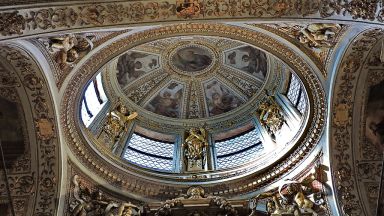
Upon leaving the Basilica di San Petronio, make an instant right turn and proceed across the bustling piazza. Continue along Via Clavature, the thoroughfare that extends from the piazza. After a brief stroll of approximately half a block, you will find the Santuario di Santa Maria della Vita situated on your left-hand side.
Santuario di Santa Maria della Vita, a splendid Baroque church, is lovingly preserved by a private museum group as part of the cultural series known as Genus Bononiae. Its origins trace back to the 13th century when a congregation of Flagellants, known for their self-flagellation and rigorous discipline, founded a church and hospital in 1287. This sacred place was named “Saint Maria of Life.” The church underwent reconstruction around 1690, with the addition of Giuseppe Tubertini’s graceful dome in 1787. Today, a portion of the church serves as an art museum, showcasing pieces related to health and healing, while the former hospital once stood across the street.
To the right of the altar, adorned with the depiction of the Madonna of Life, resides a terracotta masterpiece titled “Compianto sul Cristo” (Lamentation of Christ) crafted by Niccolò dell’Arca. Niccolò initiated his work on these figures in 1463. The composition portrays Joseph, Mary Salome, the Virgin Mary, Saint John, Mary of Cleophas, and Mary Magdalene gathered around Jesus’ body in mourning. The anguish vividly displayed on the faces of these figures has led many to believe that Niccolò derived inspiration from the actual suffering of patients in the hospital. Pilgrims would visit the Compianto to offer prayers for the sick and dying, and their donations during Easter played a pivotal role in funding the hospital and maintaining the sanctuary throughout the following year.
On the left side of the church, a doorway grants access to the hospital museum. Upstairs, the Oratorio hosts another terracotta masterpiece titled “Transito della Vergine” (Passage of the Virgins) sculpted by Alfonso Lombardi between 1519 and 1522. The fifteen statues, slightly larger than life-size, vividly depict a dramatic scene from the Funeral of the Virgins, as described in Jacobus de Voragine’s “Legenda Aurea.”
Location: Santa Maria della Vita, Via Clavature, Bologna, Metropolitan City of Bologna, Italy | Hours: From Tuesday to Sunday: 10am - 6:30pm. Last entrance 1h before closing time. | Price: €5 | Website
Read more about Santa Maria della Vita & Oratory of Battuti
Teatro Anatomico & Biblioteca Comunale dell’Archiginnasio
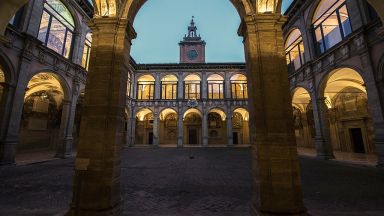
Upon leaving Santa Maria, make a right turn and head back towards Piazza Maggiore. Before reaching San Petronio, take the first left onto Via Archiginnasio. Continue along Via Archiginnasio, with San Petronio on your right side, until you reach the conclusion of the basilica. On your left-hand side, you will find the entrance to the Palazzo dell’Archiginnasio. Step inside to enter the courtyard.
Palazzo dell’Archiginnasio served as the esteemed headquarters of the University of Bologna from the 1500s until 1803. Founded in 1088, the University of Bologna holds the distinction of being the oldest university in Europe and the oldest operating university worldwide. As you explore the halls encircling the palazzo’s courtyard, you will be captivated by the splendid decorations, featuring inscriptions and monuments paying homage to the university’s esteemed educators. Thousands of coats of arms and student names also adorn the walls.
To access the first floor, ascend the stairs located on your left-hand side. Directly ahead, you will encounter the Civic Library, which has been housed in the palazzo since 1838. The library offers study rooms open to the public, where you can spend time if you securely store your belongings in a locker and present identification (un documento) to the clerk at the study hall entrance. However, the main attractions drawing visitors are the Sala dello Stabat Mater, the original hall of judges, and the wooden Anatomical Theatre constructed in 1637 for anatomy lessons. In the theatre, a technician would dissect a cadaver on the central viewing table, while the professor stood at the lectern on the far side, providing explanations to the students. The renowned Spellati (“Skinless”) statues by Erole Lelli, located on either side of the lectern, were instrumental in facilitating the professor’s teachings. Descriptions in English detailing the art and monuments within the Palazzo dell’Archiginnasio are available and provide excellent insights for visitors.
Location: Teatro Anatomico, Piazza Galvani, Bologna, Metropolitan City of Bologna, Italy | Hours: Palace:Monday to Saturday 9.00 – 19.00 Sunday and holidays 10.00 – 14.00Anatomical Theatre and Stabat Mater Room:Monday to Friday 10.00 – 18.00 Saturday 10.00 – 19.00 Sunday and holidays 10.00 – 14.00. | Price: € 3 | Website
Read more about Archiginnasio - Teatro Anatomico
Complesso di Santo Stefano
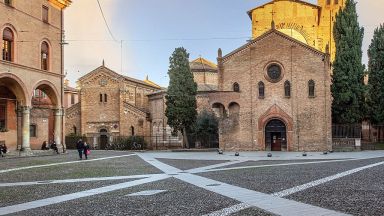
Exit the Archiginnasio and make a left turn. Continue walking past the designer clothing stores until you reach the first significant street, Via Luigi Farini. Take a left onto Via Luigi Farini without crossing the street. Keep walking until you arrive at the charming Piazza Minghetti, adorned with several stunning buildings and tall trees. This square provides an excellent setting for a leisurely lunch or a delightful coffee break.
Cut through Piazza Minghetti and turn left onto Via Castiglione. You will easily identify the Museum of the History of Bologna (Museo di Storia di Bologna, or MSB) directly in front of you, confirming that you are on the correct path.
From Via Castiglione, take the first right onto Via Sampieri, and then make the next right onto Via Santo Stefano. As you proceed, the Santo Stefano complex will come into view, positioned directly ahead of you.
Santo Stefano, an architectural ensemble initiated by Bishop Petronio in the late 5th century, stands as a remarkable complex. It is said to have been constructed atop an ancient temple dedicated to Isis, and there are indications that it was intended as a replica of the Holy Sepulchre in Jerusalem. Over time, the complex underwent further development between the 5th and 8th centuries.
Upon entering the complex, the initial structure you encounter is the Crocifisso, featuring a crypt dating back to 1019 and housing precious works of art. The second building, known as the Calvario, takes a circular form and once held the remains of Saint Petronio, accompanied by a reproduction of Christ’s tomb. The third church, named Agricola, encompasses the ancient burial sites of Saint Vitale and Saint Agricola. As you explore the complex, you will encounter a diverse range of architectural styles inspired by Roman and Byzantine influences. The complex also includes a courtyard known as Pilato’s Courtyard, the Trinità church, and a Benedictine cloister. A museum within the complex showcases a collection of paintings, sculptures, and other artistic masterpieces.
Location: Piazza Santo Stefano, Via Santo Stefano, Bologna, Metropolitan City of Bologna, Italy | Price: Free
Read more about Seven Churches and the Basilica of Santo Stefano
The Two Towers: Garisenda and Degli Asinelli
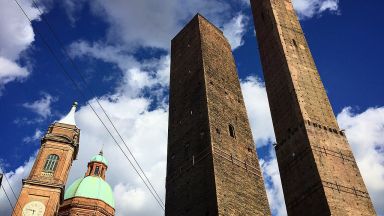
Retrace your steps towards the front of Santo Stefano and continue walking in the same direction. On your right, you will come across a charming shopping alley known as Corte Isolani. Proceed through Corte Isolani, immersing yourself in its inviting atmosphere, and then make a left turn onto Strada Maggiore. Follow Strada Maggiore as you continue your journey. Keep walking along Strada Maggiore until you arrive at the lively piazza adorned with two iconic towers, known as Piazza della Mercanzia.
During the medieval era, the landscape of Bologna was characterized by the presence of approximately 180 towers, constructed by noble families to safeguard themselves against external threats and assert their authority and influence within the region. While only around 20 towers remain today, repurposed as restaurants and bed and breakfast establishments, the city’s most renowned towers are the Two Towers (Due Torri) of Asinelli and Garisenda. These iconic structures are located just a five-minute walk east of Piazza Maggiore, at the end of Via Vittorio.
Adjacent to the towers stands the Statue of San Petronio, the patron saint of Bologna. Though limited information is available about San Petronio, it is known that he played a pivotal role in the city’s reconstruction during the 5th century, with Santo Stefano being among his notable projects. The plaque on the statue highlights how the square served as the crossroads of Bologna’s most important streets, strategically positioned near the Roman road known as the Aemilian Way, making it a hub of financial and banking activities.
Once you have admired San Petronio, consider ascending the taller tower, Torre Asinelli, to enjoy a panoramic view of the city. Access the tower through the rear entrance and pay a fee of 3 euros (cash only) to gaze upon the many sites you have recently visited. The towers are believed to have been constructed between 1109 and 1119. While Torre Garisenda may appear smaller in comparison, it is immortalized through mentions in Dante’s Divine Comedy. Additionally, the base of Torre Asinelli houses a charming shop offering handmade jewelry, ceramics, and other locally crafted products.
Location: Two Towers, Piazza di Porta Ravegnana, Bologna, Metropolitan City of Bologna, Italy | Hours: In the winter months open only on Saturday and Sunday from 9am to 5pm; from March opening hours 9-18. Tickets must be purchased at the Bologna Welcome Centre in Piazza Maggiore. | Price: Adults: € 5 | Website
Read more about The Two Towers: Garisenda and Degli Asinelli
Finestrella di Via Piella
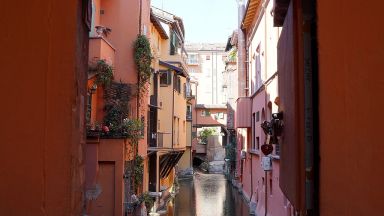
Walk away from the towers up Via Rizzoli, turning first right onto Via Guglielmo Oberdan. You are now walking through the Old Jewish Ghetto with its small cobbled and paved streets. Take the 6th turning on your left onto Via Bertiera.
The first turning on your right takes you under the Torresotto Porta Govese which belongs to the second circle of walls, begun in the late 12th century. On the side of the tower there is a Madonna with saints by Francesco Brizio from the 17th century.
Bologna boasts a comprehensive network of canals, constructed during the 12th and 13th centuries to establish a connection between the city and the Po River. While the majority of these canals now flow underground, remnants of their presence can still be observed in various areas of the city. Next to Trattoria dal Biassanot, situated at Via Piella, 16, there are windows that offer glimpses of the canals on both sides of the street.
Location: Via Piella, Bologna, Metropolitan City of Bologna, Italy | Hours: 24 Hours | Price: Free
Read more about Finestrella di Via Piella
Carry on down Via Piella until you come to the Parco della Montagnola, cross diagonally left across it back to Via dell’Indipendence.
This website uses affiliate links which earn a small commission at no additional cost to you.
